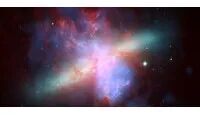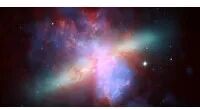
Preface
The WeChat public account of Beijing Physics aims to serve Chinese physicists and graduate students in physics research. Based on the abstracts and introductions of PRL, we provide a Chinese guide to some articles in this issue. Due to our limited capabilities, there may be inaccuracies or mistranslations. We welcome experts and scholars to point out any inaccuracies or mistranslations through the comment function at the bottom of the public account, so we can improve the quality of our service together. Comments confirmed by the editor will be displayed below the article for future readers’ reference.
Reading Navigation
01 Quantum Information and Technology (4 articles)
02 Cosmology, Astrophysics, and Gravity (6 articles)03 Elementary Particles and Field Theory (5 articles)04 Nuclear Physics (3 articles)05 Atoms, Molecules, and Optics (2 articles)06 Fluid Mechanics, Planetary Science, and Climate (none)07 Plasma and Beam Physics (2 articles)08 Condensed Matter and Materials (24 articles)09 Statistical Physics and Complex Systems (2 articles)10 Soft Matter and Biophysics (6 articles)
01
Quantum Information and Technology
Editor: Ai Qing
01-01
Gibbs-Preserving Operations Requiring Infinite Amount of Quantum Coherence
Gibbs-preserving operations have been studied as one of the standard free processes in quantum thermodynamics. Although they involve a simple mathematical structure, their operational significance remains unclear due to the potential hidden costs associated with using a class of operations motivated by computation (such as thermal operations). Here, the authors demonstrate that such hidden costs can be infinite — they propose a series of Gibbs-preserving operations that cannot be achieved with any finite amount of quantum coherence assisted thermal operations. Their results indicate that there are infinitely many Gibbs-preserving operations that require infinite thermodynamic resources to implement, raising the question of whether Gibbs-preserving operations can be considered available thermodynamic processes. This finding provides a general lower bound on the consistency cost for approximating certain types of Gibbs-preserving operations with the desired accuracy. The authors find that their lower bound is nearly tight, identifying a quantity related to the energy change induced by the execution channel as a fundamental metric for characterizing the coherence cost of approximating the execution of Gibbs-preserving operations.
(Liu Chengge)
Gibbs-Preserving Operations Requiring Infinite Amount of Quantum Coherence
H. Tajima and R. Takagi
Phys. Rev. Lett. 134, 170201 (2025)
https://doi.org/10.1103/PhysRevLett.134.170201
01-02
Variational LOCC-Assisted Quantum Circuits for Long-Range Entangled States
Long-range entanglement is an important quantum resource, particularly in topological order and quantum error correction. In fact, preparing long-range entangled states requires a deep unitary circuit, which poses significant experimental challenges. By replacing some quantum resources with local operations and classical communication, a promising avenue is provided. With these classical components, one can communicate the results of intermediate circuit measurements in distant subsystems, significantly reducing circuit depth in many important cases. However, finding short-depth local operations and classical communication-assisted circuits for preparing general long-range entangled states remains an open problem. To address this challenge, the authors propose a quantum-classical hybrid algorithm to find the optimal local operations and classical communication protocol for preparing the ground state of a given Hamiltonian. In their algorithm, they introduce an efficient method to estimate parameter gradients and use these gradients for variational optimization. Theoretically, they establish conditions under which barren plateaus do not occur, ensuring trainability for large system sizes. Numerically, the algorithm accurately solves the ground state of long-range entangled models, such as the perturbed Greenberger-Horne-Zeilinger state and surface code. The authors’ results demonstrate that their method outperforms traditional unitary variational circuits: it has practical advantages in terms of accuracy in estimating ground state energy and theoretical advantages in creating long-range entanglement.
(Liu Chengge)
Variational LOCC-Assisted Quantum Circuits for Long-Range Entangled States
Y. X. Yan, M. Z. Ma, Y. Zhou, et al.
Phys. Rev. Lett. 134, 170601 (2025)
https://doi.org/10.1103/PhysRevLett.134.170601
01-03
Simulating Sparse Hamiltonians on 2D Lattices
Systems with sparse but long-range interactions constitute a rich class of physical systems capable of exhibiting various interesting physical phenomena, including good error correction performance. This letter proposes that arbitrary sparse Pauli Hamiltonians can be simulated using two-dimensional nearest-neighbor Hamiltonians with fewer required resources than previous techniques. As an application example, the authors demonstrate how to simulate a good quantum encoding Hamiltonian, effectively approximating a quantum encoding in two dimensions.
(Zhang Haoyue)
Simulating Sparse Hamiltonians on 2D Lattices
H. Apel and N. Baspin
Phys. Rev. Lett. 134, 170602 (2025)
https://journals.aps.org/prl/abstract/10.1103/PhysRevLett.134.170602
01-04
Random Distillation Protocols in Long Baseline Telescopy
In quantum-enhanced astronomical imaging, multiple distant apertures work together by utilizing quantum resources distributed by a central server. The authors’ research shows that preprocessing the starlight received by all telescopes can enhance imaging performance without increasing resource consumption. This preprocessing method utilizes weak quantum measurements and improves the random entanglement distillation protocols in quantum information science. Intuitively, this method allows the authors to collapse the originally coherent starlight among all telescopes to a pair of telescopes with a probability arbitrarily close to 1. Subsequently, the central server can distribute entanglement only to the pair of telescopes that received the photons, thereby improving resource utilization efficiency. The authors discuss two resources that can benefit from this preprocessing: shared entanglement and shared reference frames.
(Zhang Haoyue)
Random Distillation Protocols in Long Baseline Telescopy
Yunkai Wang and E. Chitambar
Phys. Rev. Lett. 134, 170801 (2025)
https://journals.aps.org/prl/abstract/10.1103/PhysRevLett.134.170801
02
Cosmology, Astrophysics, and Gravity
Guide: Di Zhenbo; Editor: Guo Minyong
02-01
In Situ Measurements of Dark Photon Dark Matter Using Parker Solar Probe: Going beyond the Radio Window

[Featured in Physics] [Editors’ Suggestion] Researchers have turned NASA’s Parker Solar Probe into a dark-matter detector, taking advantage of its close encounters with the Sun to search for dark-photon signals.
Dark photon dark matter (DPDM) is a strong candidate for ultralight bosonic dark matter, which can be detected through the resonance conversion of dark matter into photons in a plasma environment. This paper uses in situ measurement data from the Parker Solar Probe (PSP), the first detector to drive towards the corona to search for DPDM signals. The PSP in situ measurements can exceed the typical radio window, covering a frequency range from 10 kHz to 20 MHz, which is difficult to achieve with ground-based radio astronomical detection. Furthermore, the proximity of PSP to the resonance conversion location enhances the signal flux, providing a significant advantage over ground-based measurements. As a result, PSP’s data can establish the most stringent constraints on the kinetic mixing parameter ε of DPDM in the frequency range from 70 kHz to 20 MHz: ε ≲ 10^{-14} – 10^{-13}. Research from STEREO satellite data can yield slightly weaker constraints compared to PSP. By utilizing the latest space observations, the authors surpass the constraints from early cosmic observations of the cosmic microwave background.
In Situ Measurements of Dark Photon Dark Matter Using Parker Solar Probe: Going beyond the Radio Window
Haipeng An, Shuailiang Ge and et al.
Phys. Rev. Lett. 134, 171001 (2025)
https://journals.aps.org/prl/abstract/10.1103/PhysRevLett.134.171001
02-02
First Axionlike Particle Results from a Broadband Search for Wavelike Dark Matter in the 44 to 52 μeV Range with a Coaxial Dish Antenna
The authors present the first results from a search for axionlike particles using a dish antenna. This experiment was conducted at room temperature and is sensitive to axionlike particles in the range of 44-52 μeV (10.7-12.5 GHz). The new dish antenna was proposed by the BREAD collaboration and was previously used for dark photon searches in the same mass range. To accommodate the sensitivity to axionlike particles, the BREAD dish antenna was placed in a 3.9T superconducting magnet at Argonne National Laboratory. In the presence of the magnetic field, axion dark matter converts into photons on the conductive surface of the mirror. This signal is focused onto a custom coaxial angle antenna and read out with a low-noise radio frequency receiver. No evidence of axion dark matter was observed in this range, and the authors also obtained the most stringent constraints on the axion-photon coupling constant g_{αγγ} at the 90% confidence level.
First Axionlike Particle Results from a Broadband Search for Wavelike Dark Matter in the 44 to 52 μeV Range with a Coaxial Dish Antenna
Gabe Hoshino and et al. (GigaBREAD Collaboration)
Phys. Rev. Lett. 134, 171002 (2025)
https://journals.aps.org/prl/abstract/10.1103/PhysRevLett.134.171002
02-03
Leading Axion-Photon Sensitivity with NuSTAR Observations of M82 and M87

[Featured in Physics] [Editors’ Suggestion] Two independent teams have searched for axions using x-ray observations of entire galaxies, setting some of the strictest constraints to date on the properties of these dark matter candidates.
The authors used data from the NuSTAR telescope to conduct the most sensitive search for the existence of ultralight axions. They searched for axion production from stellar bodies in the starburst galaxy M82 and the central galaxy of the Virgo cluster M87, and subsequently for conversion to hard X-rays in the background magnetic field. The authors summed over the entire stellar population when calculating the axion luminosity and considered the conversion of axions to photons using magnetic field data in simulated IllustrisTNG analog galaxies. By analyzing NuSTAR data directed towards these targets in the energy range of approximately 30 to 70 keV, the authors found no evidence for axions, which places reliable constraints on the axion-photon coupling for m_a ≲ 10^{-10} eV at the 95% confidence level.
Leading Axion-Photon Sensitivity with NuSTAR Observations of M82 and M87
Orion Ning, Benjamin R. Safd.
Phys. Rev. Lett. 134, 171003 (2025)
https://journals.aps.org/prl/abstract/10.1103/PhysRevLett.134.171003
02-04
NuSTAR Bounds on Radiatively Decaying Particles from M82

[Featured in Physics] [Editors’ Suggestion] Two independent teams have searched for axions using x-ray observations of entire galaxies, setting some of the strictest constraints to date on the properties of these dark matter candidates.
The authors used data from the NuSTAR telescope to conduct the most sensitive search for the existence of ultralight axions. They searched for axion production from stellar bodies in the starburst galaxy M82 and the central galaxy of the Virgo cluster M87, and subsequently for conversion to hard X-rays in the background magnetic field. The authors summed over the entire stellar population when calculating the axion luminosity and considered the conversion of axions to photons using magnetic field data in simulated IllustrisTNG analog galaxies. By analyzing NuSTAR data directed towards these targets in the energy range of approximately 30 to 70 keV, the authors found no evidence for axions, which places reliable constraints on the axion-photon coupling for m_a ≲ 10^{-10} eV at the 95% confidence level.
Leading Axion-Photon Sensitivity with NuSTAR Observations of M82 and M87
Orion Ning, Benjamin R. Safd.
Phys. Rev. Lett. 134, 171003 (2025)
https://journals.aps.org/prl/abstract/10.1103/PhysRevLett.134.171003
02-04
Leading Axion-Photon Sensitivity with NuSTAR Observations of M82 and M87
In this section, we will continue to provide summaries of the articles published in this issue, covering various topics in physics.